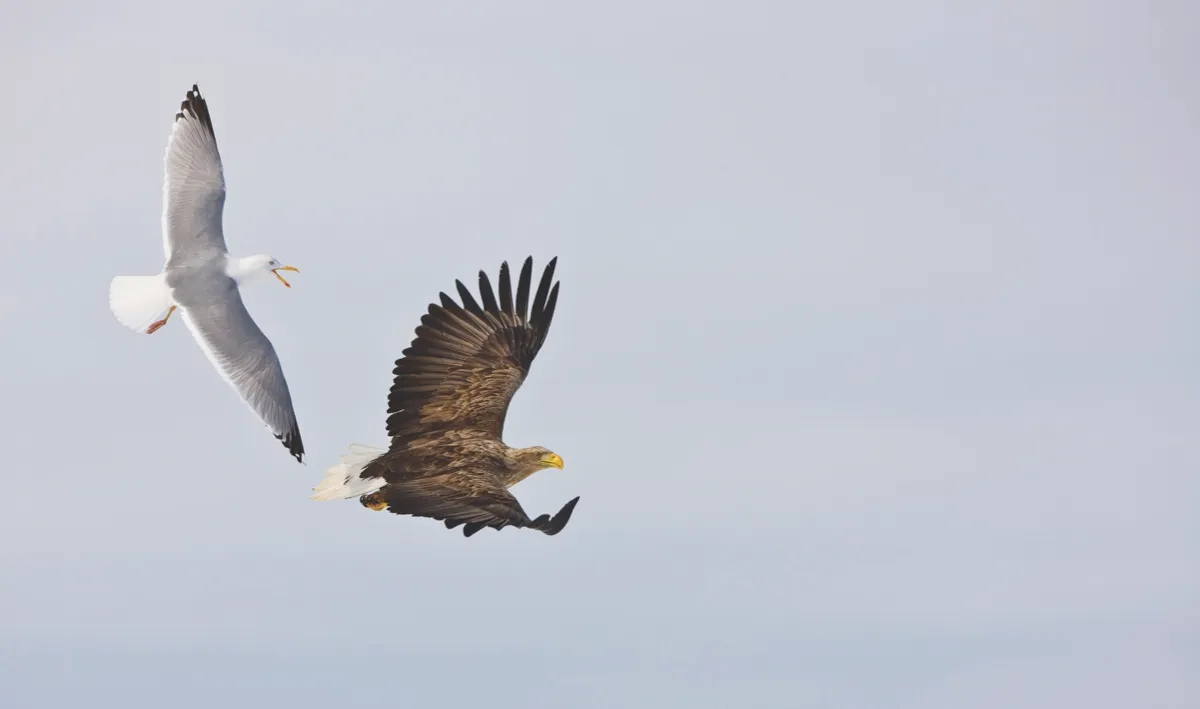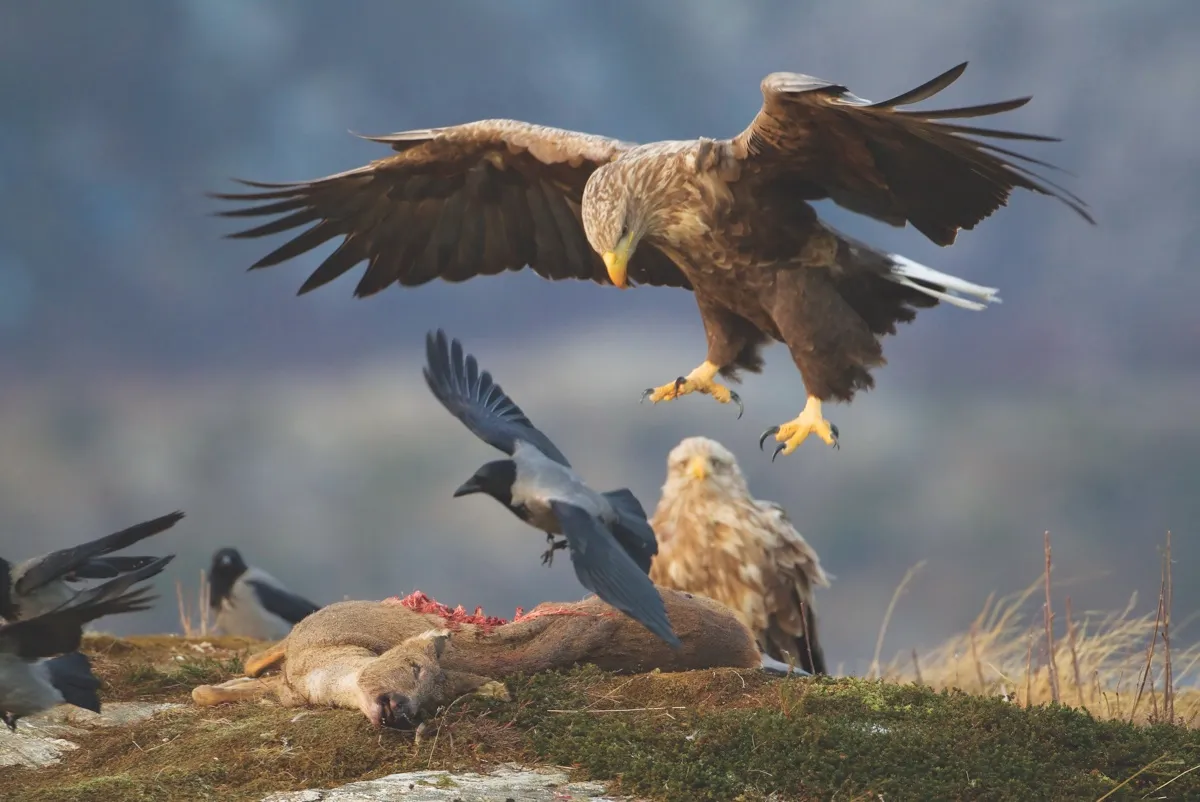White-tailed eagles. A bit like London buses? You wait and wait for one to come along and then, the old adage – several arrive at once. That, at least, has been my experience of searching for Britain’s largest bird of prey. For years I’ve trudged along the rugged coastline of Lochaber, the Isle of Jura, the Morvern peninsula hoping to catch a glimpse of this rare, magnificent raptor with its numerous names: sea Eagle in English; in Gaelic, Iolaire ghlas, meaning the grey eagle; Iolaire chladaich, the shore eagle; or Iolaire sùil na grèine, the eagle with the sunlit eye.
And how on earth could I miss such a huge bird whose wingspan can reach 2.5m, whose vast wings inspired the cliché of resembling ‘flying barn doors’? There were fleeting glimpses: a white-tailed eagle perched on a rock by the shoreline or in the branch of a tree. But always the birds were a long way off, static. I wanted to study the eagles in flight, hunting, soaring, interacting with other birds. So I kept returning to the West Highlands, year after year, hoping to properly watch white-tailed eagles. I learnt (with difficulty) that not seeing white-tailed eagles was far more common than seeing them. I learnt that midges were immune to most midge-repellents, and that smoking a pipe to repel the midges was an experience even more miserable than midges themselves. But it was not all frustration. I also had memorable experiences and witnessed some extraordinary wildlife as I walked through this vast, largely uninhabited part of Scotland.
Dozing in my tent one night, on a shore miles from the nearest road, I woke to hear slow, heavy footsteps on the shingle. Crunch, crunch… my heart skipped a beat and I cowered in the tent, hardly daring to breath. Crunch, crunch… closer and closer. Who on earth could be out here in the middle of the night? “Hello, is there somebody there?” I ventured. No answer. I put my boots on, unzipped the flysheet and sprung out. Standing 12 feet away, huffing and snorting in the half-light, was a huge red deer hind. Later that night, I woke again to what sounded like the entire shingle bank collapsing around me, as a large herd of red deer made their way along the beach, hooves clattering over the stones.

THE EAGLE APPEARS
Finally, I struck gold. From a clifftop overlooking a narrow straight of water between an island and the mainland, I saw a white-tailed eagle hunting, soaring and doing everything I’d ever dreamed of. The rising tide had pushed a huge volume of water into the narrows and, with the water, came a surge of fish. With the fish came gulls and seals to feed on the fish. And with the gulls, came the eagle. This male had a nest several miles away. It was mid-June, so I presumed he had young on the nest and his mate, the female, was keeping guard there. The male was hunting overtime to provide for his family. The narrows were his preferred hunting ground, which meant I was able to watch him there over several days. Most of the time the white-tailed eagle was perched on a young larch tree overlooking the narrows. A large grey shape, he caused the tree to sway back and forth with the force of his landings. Through my binoculars I could see his heavy yellow bill and bright yellow talons. Most conspicuous was his pale grey head and neck. Once, when he left his perch, the eagle flew straight towards my clifftop perch. He kept soaring towards me – surely he had seen me?
Whoosh! At the last minute, he banked away and landed on the hillside behind me. His head and the tops of his wings were silhouetted above the skyline. Straight away a hooded crow swooped down and began to mob the eagle, dive-bombing the sea eagle repeatedly. Birds of prey endure this mobbing endlessly. Corvids and gulls will harass sea eagles, outraged at the large bird’s threatening presence over their territory, screaming at the eagle repeatedly till the eagle has had enough and flies off to a quieter perch.

PIRATE IN PURSUIT
When hunting, the white-tailed eagle would usually trail a gull who was holding a fish in its crop. The eagle’s technique was one of patient intimidation. It didn’t attempt to attack the gull. Rather it would loom over and follow the gull wherever it went, breathing down its neck. After five or 10 minutes, the gull would relent and jettison its catch. I’d watch the fish fall, sparkling in the sun, towards the sea. At this moment, everything I’d read about the white-tailed eagle was turned on its head. Often described as a sluggish, vulturine bird, the eagle instead adopted a falcon’s speed and agility. It folded its huge wings back to shoot down after the falling fish. As long as the gull dropped its fish from a sufficient height, it was the easiest thing in the world for the eagle to swoop down and pluck the fish from the sky.
Besides piracy, the white-tailed eagle’s other method of hunting is to fly low over the water to scoop fish from near the surface. Watching the eagle fish like this was mesmerising. The eagle seemed to spot the prey from a long way off, dropping from its perch, flying fast and low in a straight line before rising a few feet, pulling its wings up behind it (as if about to land), then plunging its talons into the water to seize a fish. Besides fish, carrion is important to sea eagles, especially in the winter months. Live prey is also taken: shore birds, wildfowl (moulting or injured birds), rabbits, hares and other small mammals.

After years of searching, I now see white-tailed eagles often on my travels in Scotland. Successful reintroduction schemes on the west and, more recently, east coasts of Scotland have led to roughly 100 breeding pairs. Like all large birds of prey they are slow breeders (slow to reach breeding age, slow to rear their young and rarely raise more than two chicks per year). But white-tailed eagles have recolonised many of their ancestral breeding territories, recognised in place-names along the Scottish seaboard, such as Creag na h-Iolaire, the eagle’s rock. How long before they slip across the border and establish themselves again over the great river estuaries, Lundy, the Lake District, all former haunts of the white-tailed eagle in England? What a prospect that is. Let’s make these magnificent birds welcome when they return.
WHERE TO SEE SEA EAGLES
• Kyle Rhea Narrows
On this ferry crossing from Glenelg to Kylerhea on Skye, spot white-tailed eagles, otters and seals.
• Sound of Jura
See the majestic birds on the boat trips from Tayvallich, Crinan and Loch Sween to the Gulf of Corryvreckan.
• Tentsmuir Point
The Tay Estuary is a good place to look for Scotland’s east coast eagles.
• The Small Isles
Top spots include the Isles of Rum and Canna.
• Loch Sunart
Visit the Garbh Eilean viewing hide in the Ardnamurchan peninsula.
• Isle of Mull
With the highest density of white-tailed eagles in the land, this an ideal place to watch the birds.
Images: Colin Carter/Getty
